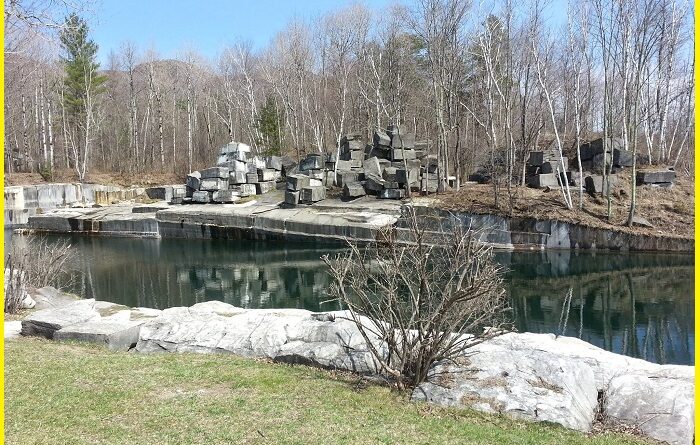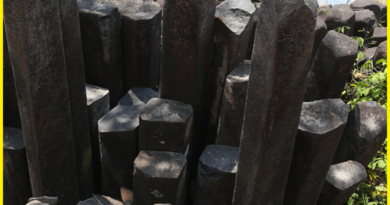Dorset Marble Quarry- First Marble Quarry in USA and A Popular tourist destination
Dorset Marble Quarry
Dorset Marble Quarry is a historic quarry located in the town of Dorset, Vermont, USA. The quarry is known for its distinctive marble, which has been used in many notable buildings and monuments, including the New York Public Library, the US Supreme Court building, and the Washington Monument. The quarry was first opened in the early 19th century, and by the mid-1800s, it had become one of the largest marble producers in the United States. The marble from the quarry was prized for its purity and whiteness and was considered to be of the highest quality. The quarry operated for over 100 years until it was closed in the 1970s due to a decline in demand for marble. Today, the quarry is a popular destination for visitors to the area, who can explore the site and learn about the history of marble production in Vermont. The quarry also serves as a reminder of the important role that Vermont played in the development of the marble industry in the United States.
Geology
The marble quarry is unique in that it’s a deep, arch-shaped cavern dug directly into the east slope of Mount Aeolus. The cave features many passageways and a large pond of water that freezes solid in the wintertime, making it a perfect unique spot for ice skating. Mount Aeolus is a mountain located in the town of Dorset in southern Vermont. It is part of the Taconic Mountains range and is one of the highest peaks in the region, with an elevation of 1,029 meters. The mountain is composed of phyllite and marble rock.
The marble deposits at the quarry were formed during the Paleozoic era, over 350 million years ago. It is part of a larger formation known as the Stockbridge Marble. This marble is a metamorphic rock, which means that it was formed from the transformation of a pre-existing rock under high heat and pressure. The Stockbridge Marble was originally limestone, which was compressed and heated deep underground, causing it to recrystallize and transform into marble.

The marble at the Dorset Quarry is known for its purity and whiteness, which is due in part to its composition. It is due to the Calcite mineral. In addition to its composition, the marble at the Dorset Quarry is also notable for its texture. The marble has a fine-grained, homogenous texture, which makes it ideal for use in sculpting and carving.
Dorset Marble quarry history
The history of the Dorset Marble Quarry dates back to the early 19th century, when marble was first discovered in the area. In 1785, a settler by the name of Isaac Underhill discovered a deposit of what he thought was limestone on his property. However, it was later determined that the material was actually marble.
In 1803, the first quarry was opened in Dorset, and by the mid-1800s, the quarry had become one of the largest marble producers in the United States. The marble from the Dorset quarry was known for its high quality and purity, and it was in great demand for use in buildings and monuments.
Dorset marble quarry Vermont was operated by a number of different companies over the years, including the Vermont Marble Company, which became one of the largest marble producers in the world. The marble from the Dorset quarry was used in many notable buildings and monuments, including the New York Public Library, the US Supreme Court building, and the Washington Monument.
Despite its success, the quarry faced a number of challenges over the years. Labor disputes, financial difficulties, and the decline in demand for marble all contributed to the quarry’s eventual closure in the 1970s. Today, the Dorset Marble Quarry is a popular destination for visitors to the area, who can explore the site and learn about the history of marble production in Vermont.
Also read- Florida USA-Places to travel in Florida near the Gulf of Mexico
Depth of Dorset marble quarry
The exact depth of the Dorset Marble Quarry is not clear, as it varied over the course of the quarry’s operation. However, it is known that the quarry was quite deep, with some estimates suggesting that it may have reached depths of over 182 meter.
The quarry was originally started as an open-pit operation, with workers using hand tools to extract the marble from the surface. As demand for marble increased, however, the quarry expanded to include underground mining as well. Workers would tunnel into the mountain to reach deeper deposits of marble. Over time, the quarry grew deeper and more complex, with a network of tunnels and chambers extending deep underground.
Dorset marble quarry swimming
Swimming in the Dorset Marble Quarry is not recommended, and in fact, it is illegal. While the quarry may look like an inviting spot for a swim, it is actually quite dangerous. The quarry is located on private property, and there are no lifeguards or other safety personnel on duty. The water in the quarry is extremely cold, and the depth of the quarry varies, making it difficult to judge the depth of the water in any given spot.
There are also hidden underwater hazards, such as submerged machinery and rock formations, which can pose a serious danger to swimmers. Overall, while the Dorset Marble Quarry may be a beautiful spot to visit and explore, it is important to respect the safety rules and regulations in place and avoid swimming in the quarry.
How to Get Dorset marble quarry
The Dorset Marble Quarry is located in the town of Dorset, Vermont, USA. The quarry is situated on private property, but it is open to the public for visits. To get to the quarry, you can drive to the town of Dorset and follow signs for the quarry. The entrance to the quarry is located on Dorset Hollow Road, just off Route 30.
Once at the quarry, visitors can explore the site on foot. There are paths and trails throughout the quarry, and signs and interpretive displays that provide information about the history of marble production in Vermont. Visitors can also see the remains of the quarry’s underground tunnels and chambers, and learn about the tools and techniques used by the workers who extracted the marble from the mountain.



